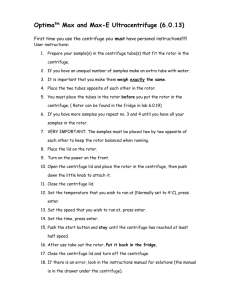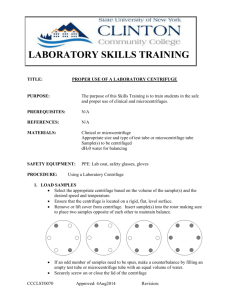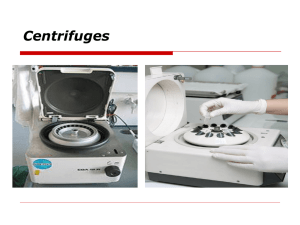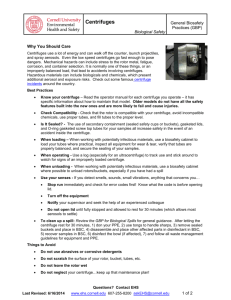Lab 3. Centrifuges
advertisement
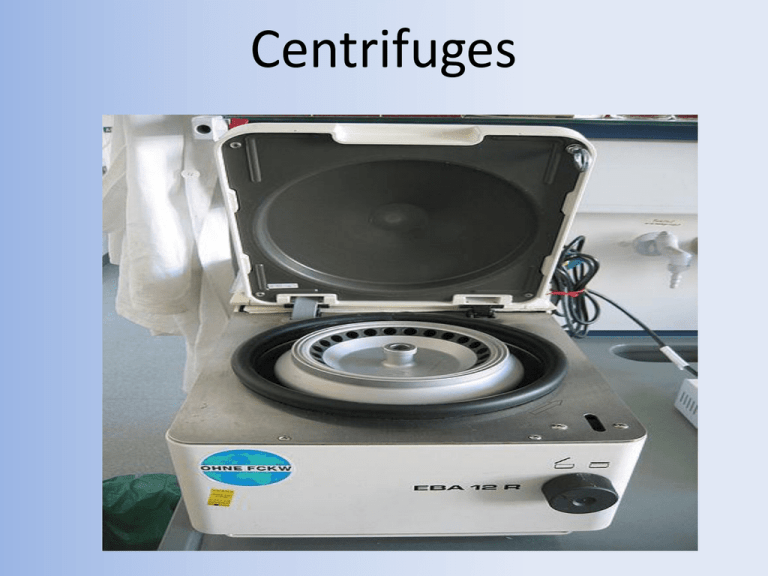
Centrifuges 2 3 Objective Centrifugation is used to separate immiscible liquids and solids from liquids. The separation is carried out by the application of centrifugal force. Definition • A laboratory centrifuge is a piece of laboratory equipment , driven by a motor which spins liquid samples at high speed. • Centrifuges are used in – chemistry, biology, and biochemistry for isolating and separating suspensions. 5 MLI-mde 210, 311 Operation • • separation of particles from a solution two fractions are formed: 1. sediment (pellet, solid phase) 2. supernatant (liquid phase) The figure was found at http://www.steve.gb.com/science/molecular_biology_methods.html (Feb 2008) Centrifugation separation of particles from a solution according to their size, shape, density, viscosity of the medium and rotor speed. The rate of centrifugation is specified by the acceleration applied to the sample, typically measured in revolutions per minute (RPM) or relative centrifugal force (RCF). Rotor Generally spoken, there are two main types of rotors: • Fixed-angle rotor • Swing-out rotor (= horizontal rotor) 8 MLI-mde 210, 311 Design Rotor objectives • The rotor is closed by a rotor lid. • The rotor is located in a rotor chamber which is covered by a metal centrifuge lid. • During the run, the lid is locked. • The lid protects the user from being injured by touching a rapidly spinning rotor. 9 MLI-mde 210, 311 Centrifuge tubes • Centrifuge tubes or centrifuge tips are tapered tubes of various sizes made of glass or plastic. • The most commonly encountered tubes are of about the size and shape of a normal test tube (~ 10 cm long). • Micro-centrifuges typically accommodate microcentrifuge tubes with capacities from 250 μl to 2.0 ml These are exclusively made of plastic. 10 MLI-mde 210, 311 Centrifuge tubes Three microcentrifuge tubes: 2 mL, 1.5 mL and 200 μL (for PCR). Four screw-top micro-centrifuge tubes. 11 MLI-mde 210, 311 Types of centrifuge There are at least five types of centrifuge: • preparative centrifuge • analytical centrifuge • angle fixed centrifuge • swing head centrifuge • haematocrit centrifuge 12 MLI-mde 210, 311 Safety aspects • The load in a laboratory centrifuge must be carefully balanced. Small differences in mass of the load can result in a large force imbalance when the rotor is at high speed. This force imbalance strains the spindle and may result in damage to centrifuge or personal injury. Some centrifuges have an automatic rotor imbalance detection. • Before starting a centrifuge, an accurate check of the rotor lockage as well as the lid lockage is mandatory. 13 MLI-mde 210, 311 Safety aspects • Centrifuge rotors should never be touched while moving, because a spinning rotor can cause serious injury. – Modern centrifuges generally have features that prevent accidental contact with a moving rotor as the main lid is locked during the run. 14 MLI-mde 210, 311 The figures were found at http://www.chem.arizona.edu/tpp/chemt/CAn/Graphics/centrifuge/blood%20centrifugation.png and http://www.academic.marist.edu/~jzmz/HematologyI/Intro3.html (Feb 2008)

